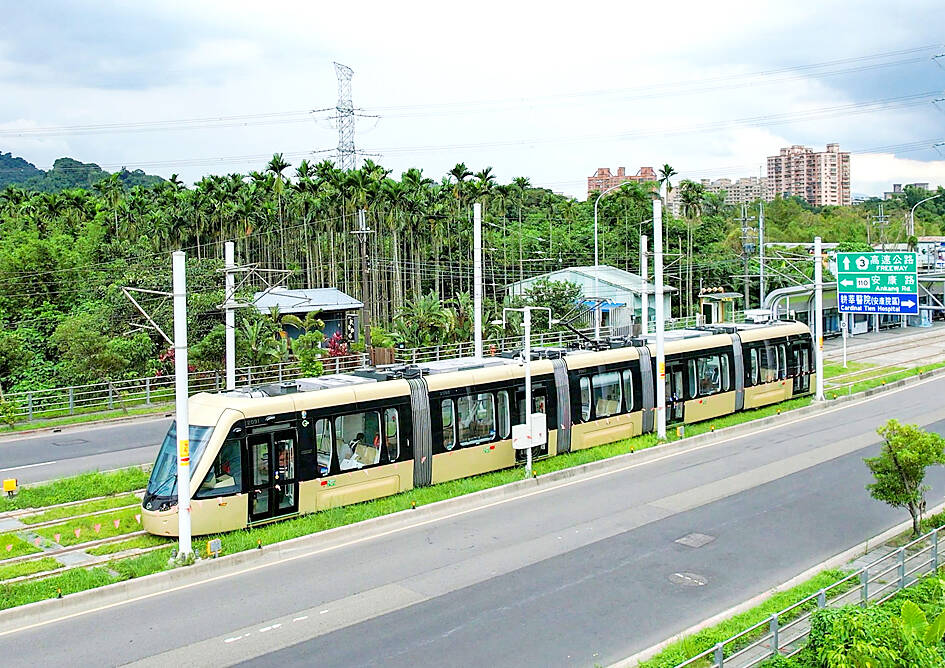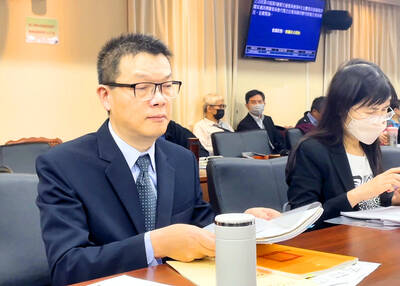Residents in New Taipei City’s Ankeng District (安坑) said the local light rail system might have a positive influence, but raised questions about its practicality.
The Ankeng light rail system, which is to commence operations after the Lunar New Year holiday, would cut travel time for commuters from Ankeng to downtown Taipei or New Taipei City by 15 to 20 minutes, the city government said.
According to the initial plan, there would be one train every 15 minutes during peak time and additional interval trains would run between the densely populated Ankang Station (安康) and Shisizhang Station (十 四張).

Photo courtesy of the New Taipei City
To encourage people to take the light rail system, the city’s Transportation Department arranged shuttle buses, set up more YouBike 2.0 rental stations and increased parking spaces for vehicles and motorbikes along the light rail.
“People living in Ankeng have been waiting for the infrastructure for nearly 30 years,”AmKhenn Culture Studio chief executive officer Wu Bo-wei (吳柏瑋) said.
However, the stations along the light rail system are far away from densely populated areas and attractions, he said, citing the example that it takes 10 minutes to walk from Sunshine Sports Park Station (陽光運動公園站) to the park.
Many communities along the line from Shuangcheng Station (雙城站) to Jinwen University of Science and Technology Station (景文科大站) are on hillsides, which makes commuting on the light rail difficult, he said.
People can take the line to Shisizhang Station, which is also on the Taipei MRT Circular Line, but would have to transfer at Dapinglin Station (大坪林站) before entering Taipei, he said.
A resident living near New Taipei City’s Rose China Town, a hillside community, said it takes 10 to 20 minutes of walking uphill from Rose China Town Station (玫瑰中國城站) to the community, adding that riding a motorbike would be more convenient than taking a shuttle bus.
Ankeng Borough Warden Lin Yung-huei (林永輝) said that people are unlikely to take the light rail system to commute from home to Taipei, as it takes too long.
Elderly people or those who are not in a hurry are more likely to take the system, he said, adding that setting up more stops for the shuttle bus could encourage the elderly to go out.
People commuting to New Taipei City’s Jhonghe (中和), Yonghe (永和), Banciao (板橋) and Sinjhuang (新莊) districts are more likely to take the light rail system, as there tends to be traffic congestion in those areas, Sindian Borough Warden Yu Yen-lan (游炎嵐) said.
A student surnamed Lin (林), who lives near Jinwen University of Science and Technology, said that going to the light rail station is more inconvenient than taking a bus outside the school gate.
Three other students who usually commute by motorbike said that they would not consider taking the light rail system.
A resident surnamed Lee (李), who has poliovirus, said that the light rail system is safer for him compared with buses.
New Taipei City Councilor Chen Yi-chun (陳儀君) of the Chinese Nationalist Party (KMT) said the light rail system provides a new option for people, adding that she believed people would be more willing to take it after shuttle buses and YouBike stations have been installed.
As housing prices in Ankeng are lower than in Sindian, more people might move there and help the area’s development, she added.
Many new houses have been built in Ankeng and the transaction volume has grown significantly, Sinyi Realty Inc branch manager Chueh Chien-cheng (闕建丞) said, adding that the overall housing prices in the area have increased by about 30 percent.
New housing prices rose from about NT$350,000 to NT$500,000 per ping around Ankang Station from 2017 to last year, he said.
New Taipei City Councilor Chen Nai-yu (陳乃瑜) of the Democratic Progressive Party said that tourism could expand in the area.
The Jing-Mei White Terror Memorial Park (白色恐怖景美紀念園區), Sindian Prison (新店監獄) and Ankeng Execution Ground (安坑刑場) are along the light rail line, providing good material for people to learn about the history of the White Terror era, she said.

‘DENIAL DEFENSE’: The US would increase its military presence with uncrewed ships, and submarines, while boosting defense in the Indo-Pacific, a Pete Hegseth memo said The US is reorienting its military strategy to focus primarily on deterring a potential Chinese invasion of Taiwan, a memo signed by US Secretary of Defense Pete Hegseth showed. The memo also called on Taiwan to increase its defense spending. The document, known as the “Interim National Defense Strategic Guidance,” was distributed this month and detailed the national defense plans of US President Donald Trump’s administration, an article in the Washington Post said on Saturday. It outlines how the US can prepare for a potential war with China and defend itself from threats in the “near abroad,” including Greenland and the Panama

A wild live dugong was found in Taiwan for the first time in 88 years, after it was accidentally caught by a fisher’s net on Tuesday in Yilan County’s Fenniaolin (粉鳥林). This is the first sighting of the species in Taiwan since 1937, having already been considered “extinct” in the country and considered as “vulnerable” by the International Union for Conservation of Nature. A fisher surnamed Chen (陳) went to Fenniaolin to collect the fish in his netting, but instead caught a 3m long, 500kg dugong. The fisher released the animal back into the wild, not realizing it was an endangered species at

The High Prosecutors’ Office yesterday withdrew an appeal against the acquittal of a former bank manager 22 years after his death, marking Taiwan’s first instance of prosecutors rendering posthumous justice to a wrongfully convicted defendant. Chu Ching-en (諸慶恩) — formerly a manager at the Taipei branch of BNP Paribas — was in 1999 accused by Weng Mao-chung (翁茂鍾), then-president of Chia Her Industrial Co, of forging a request for a fixed deposit of US$10 million by I-Hwa Industrial Co, a subsidiary of Chia Her, which was used as collateral. Chu was ruled not guilty in the first trial, but was found guilty

DEADLOCK: As the commission is unable to forum a quorum to review license renewal applications, the channel operators are not at fault and can air past their license date The National Communications Commission (NCC) yesterday said that the Public Television Service (PTS) and 36 other television and radio broadcasters could continue airing, despite the commission’s inability to meet a quorum to review their license renewal applications. The licenses of PTS and the other channels are set to expire between this month and June. The National Communications Commission Organization Act (國家通訊傳播委員會組織法) stipulates that the commission must meet the mandated quorum of four to hold a valid meeting. The seven-member commission currently has only three commissioners. “We have informed the channel operators of the progress we have made in reviewing their license renewal applications, and